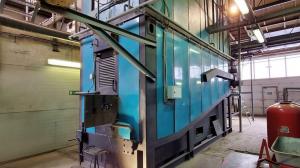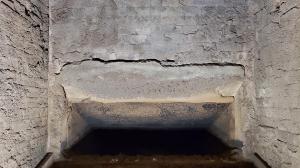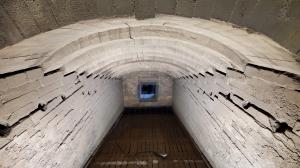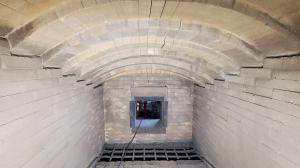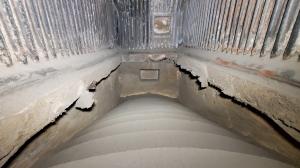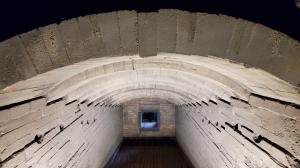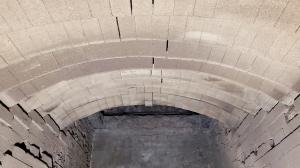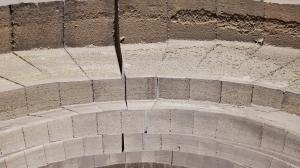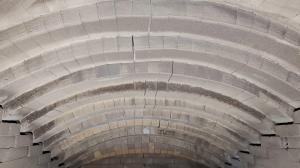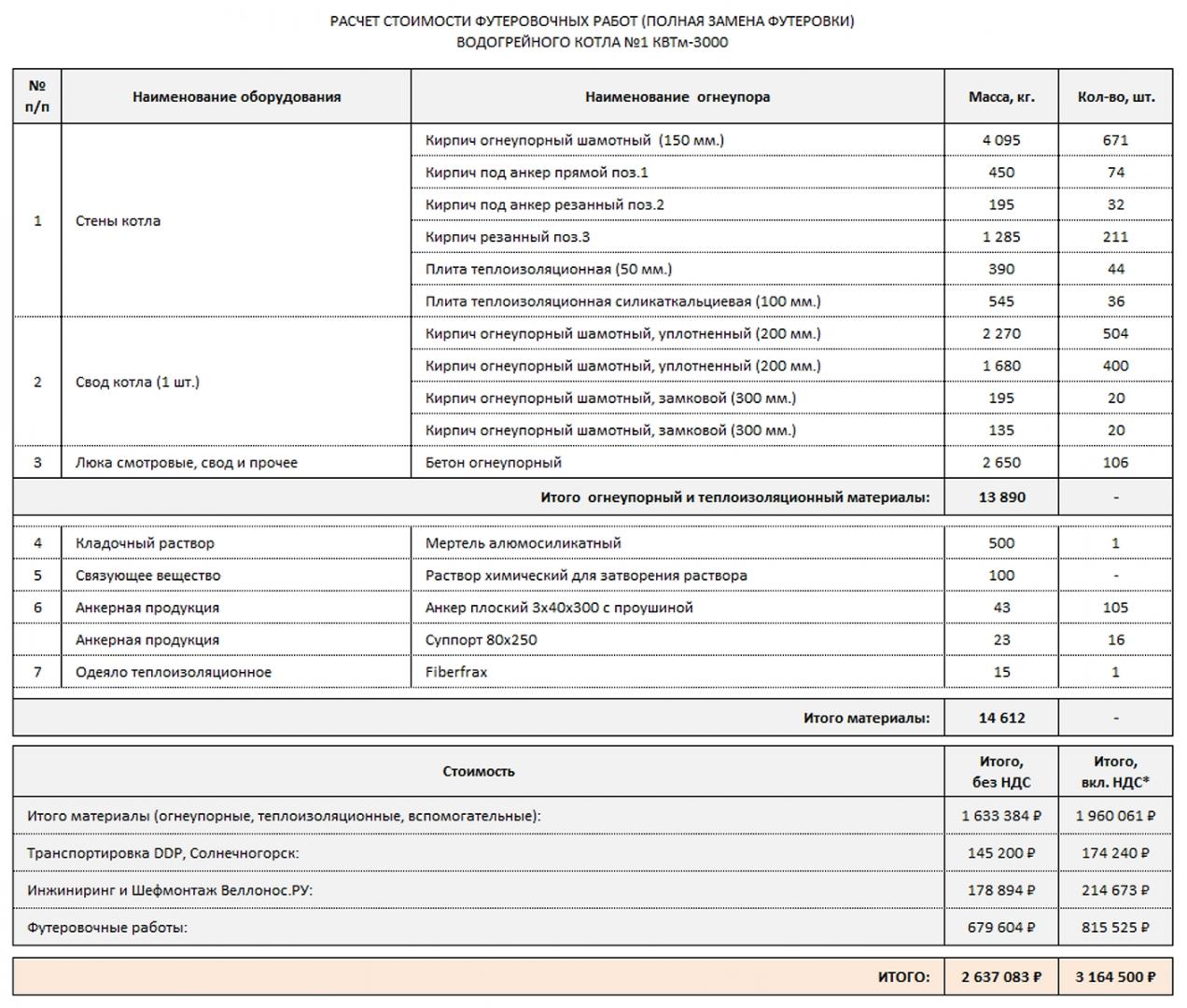On February 25, 2020, specialists of LLC Wellons.RU performed internal inspection of the technical condition of the refractory lining of the boilers KVTm-3000 and KVT-4000 E. The results of the inspection of the lining are shown in this report.
1. BOILER №1 КВТм-3000 (year of manufacture: 2012):
An external inspection of the boiler did not reveal any visible defects in the casing of the boiler body, there are no obvious burnouts of the shell or deformation of the boiler body as a result of a possible increased temperature effect on the body (for example, in case of technological conditions, overheating of the boiler, collapse of the lining of the boiler walls, etc.). The absence of visible external defects, as well as the absence of ash deposits or fuel chips around the boiler, allows us to conclude that the equipment of the hot water boiler is in a normal technical condition and is not operated beyond the norm on a regular basis.
Internal inspection of the lining of the boiler (single-arch design of the lining of the furnace of the boiler):
The lining of the fuel chute, as well as the tip of the transition section into the convection / pipe part of the boiler, are made of monolithic refractory concrete. The technical condition of refractory concrete is in satisfactory condition. Existing small chips, cracks are not critical and do not adversely affect the structural strength of the lining of these sections and the boiler as a whole.
The walls of the furnace (end and side) in the grate zone are made of refractory molded aluminosilicate direct brick of the ША-5 (ШБ-5) type. The lin-ing of the furnace walls, the tuyere holes of the air supply for combustion in the grate zone, are in satisfactory condition. Accordingly, it can be assumed that the heat-insulating layer of the walls must also be in a satisfac-tory technical condition, due to the absence of visible places for repairing the lining and, accordingly, visible burnouts on the walls of the boiler from the outside. Violation of the geometry of the walls, mainly in the area of the tuyere holes, is most likely associated with the design feature of the boiler, and was formed during the initial laying of the refractory lining, when the brickwork was fitted to the boxes of the tuyere holes. Refractory condition the lining of the walls in the ash discharge zone into the ash conveyor is in the best condi-tion with respect to the lining of direct fuel combustion. It can be seen that the main combustion of fuel is practically in the fuel supply zone, which is also confirmed by the presence of slag deposits on the walls of the boiler at the transition section to the boiler afterburning zone. The walls of the furnace (end and side) in the grate zone are made of refractory molded aluminosilicate direct brick of the ША-5 (ШБ-5) type. The lining of the furnace walls, the tuyere holes of the air supply for combustion in the grate zone, are in satisfactory condi-tion. Accordingly, it can be assumed that the heat-insulating layer of the walls must also be in a satisfactory technical condition, due to the absence of visible places for repairing the lining and, accordingly, visible burn-outs on the walls of the boiler from the outside. Violation of the geometry of the walls, mainly in the area of the tuyere holes, is most likely associated with the design feature of the boiler, and was formed during the ini-tial laying of the refractory lining, when the brickwork was fitted to the boxes of the tuyere holes.
Side and end walls in the boiler afterburning zone (over-arch space), as well as protective refractory lining of the lower side and end collectors, the lining of the process hatch - is in normal technical condition. The remnants of the formwork of the collectors (for the device of a monolithic lining made of refractory concrete) do not adversely affect the technological process of heating water in the convection part of the boiler.
Considering the life of the boiler (more than 7 years), it can be said that the condition of the lining in the boiler as a whole is satisfactory, with the exception of the arched part of the furnace device. The technical condition of the vault, its design features do not allow us to consider the refractory lining of boiler No. 1 reliable in the long term, for the reasons described below.
The combustion chamber arch – the main structural feature of the existing arch - is a gentle arch with a large radius of curvature. This arch is al-so made of refractory bricks with a thickness of 150 mm, using one type of shaped product. The design of such a vault does not provide the proper strength of the vault, especially at sufficiently frequent stops of techno-logical equipment, i.e. with frequent start / stop cycles of the boiler or heating / cooling of the refractory lin-ing. Due to residual temperature deformations generated by the pressure of the arch on the walls of the lining and the metal walls of the boiler body, respectively, the “opening” of the arch occurs, i.e. subsidence of the central dome with the formation of large open cracks. When the heating / cooling cycle is repeated, this pro-cess progresses, as a result of which the castle bricks fall out and the annular segment of the arch is destroyed. A visual inspection shows that for the laying of one half-ring of the arch, one type of shaped product was used, which in practice, almost never allows fold the ring of the correct radius / diameter.
The extreme row of the vault shows the improperly selected layout of the refractory bricks and, as a result, a violation of the design radius of the semicircle of the vault with a violation of the structural strength. When visual inspection of the opened "cracks" we did not find even residual traces of the use of masonry mortar. Probably, the arch is difficult with the use of "dry" masonry, i.e. without the use of refractory masonry mortar. We strongly recommend the use of masonry mortar with chemical setting accelerators for the installation of arches, especially arches with a large radius of curvature, the so-called “flat arches”. For unloaded vaults, it is recommended to use a brick with a thickness of at least 200 mm. This brick thickness allows minimizing the risks of arch sagging to a certain limit. All of the above reasons for reducing the strength of the vault design are solved using more “correct” / steep arches, i.e. vault structures with a vault diameter equal to the width of the furnace space. For example, with the width of the furnace space equal to 1600 mm, the radius of the arch should be as close as possible to 800 mm, as far as the design of the boiler furnace allows.
Regardless of the discussion, which design of the arch is more preferable, the actual state of the arch shows that in each half-ring of the arch there is a large opening of the refractory masonry and in one or more places. A number of vault segments have pronounced dips, i.e. from a circular vault they gradually turn into a flat one, in the future - the destruction of these segments and almost the entire vault. Destruction of the roof will lead to disruption of the heat production process and to a forced shutdown of the boiler for lining repair. Subsequently, when carrying out preventive work on cleaning the roof from ash and slag deposits, we strongly recommend that you first examine the condition of the roof for its strength, before cleaning, and if necessary, provide measures to ensure load distribution before the worker is allowed to enter the boiler furnace.
Summary: Given the life of the existing lining, as well as the design of the arch, it is difficult to predict how soon complete or partial destruction of the lining of the arch can occur. In any case, we recommend that you foresee the costs of replacing the boiler lining as a whole, for the following reasons:
- a sufficiently long service life of the existing refractory (more than 7 years);
- the inappropriateness of the reconstruction of the lining of the arch, as the most constructively com-plex and responsible section of the boiler furnace;
- replacement of the vaulted area in case of collapse carries a large financial and time costs;
- restoration of the vault according to the existing scheme does not solve design flaws;
- a relatively small amount of refractory and heat-insulating materials, as well as lining work when re-placing 100% of the volume of the lining of the boiler;
- complete replacement of the lining of the boiler, with the installation of a new arch of the “correct” design and the implementation of additional measures to increase the structural strength, as well as the device of the multi-layer lining of the walls of the boiler, will bring guaranteed durability of the lin-ing as a whole for many years of operation of boiler No. 1.
To estimate the budget of possible costs for lining works, we made an approximate calculation, which is based on the measurements made during the technical inspection, as well as on the basis of the outline draw-ing shown in the boiler passport. Unfortunately, detailed technical documentation, namely detailed lining drawings for these boilers, is missing. The calculations are based on the terms of the EPC contract and include the following work: engineering; selection, manufacture and supply of refractory and heat-insulating materi-als; necessary anchor production; transport services; lining work (work on breaking the existing refractory is not included in the cost of the work). The cost of replacing the refractory lining of the boiler is shown in the ta-ble (total with VAT incl @ EPC = ~$US 40K. Breakdown of materials & services shown below):
